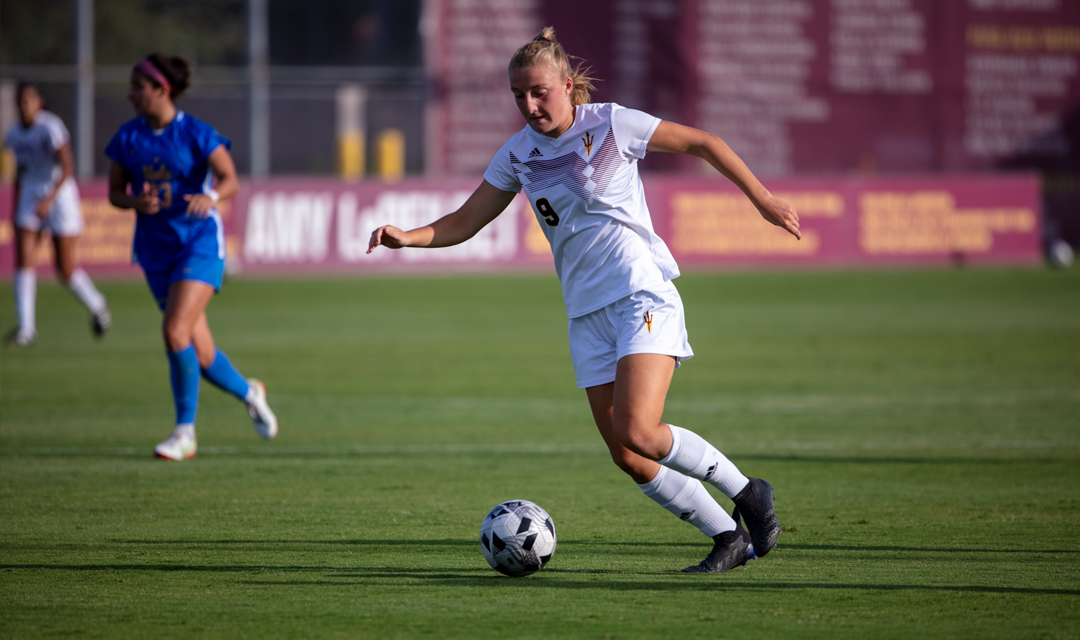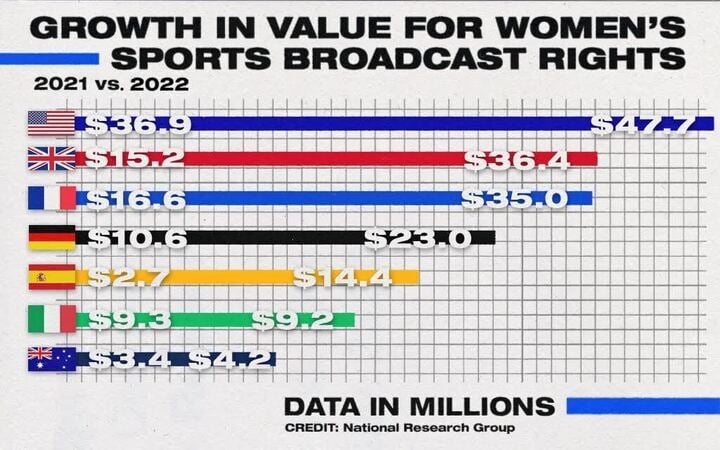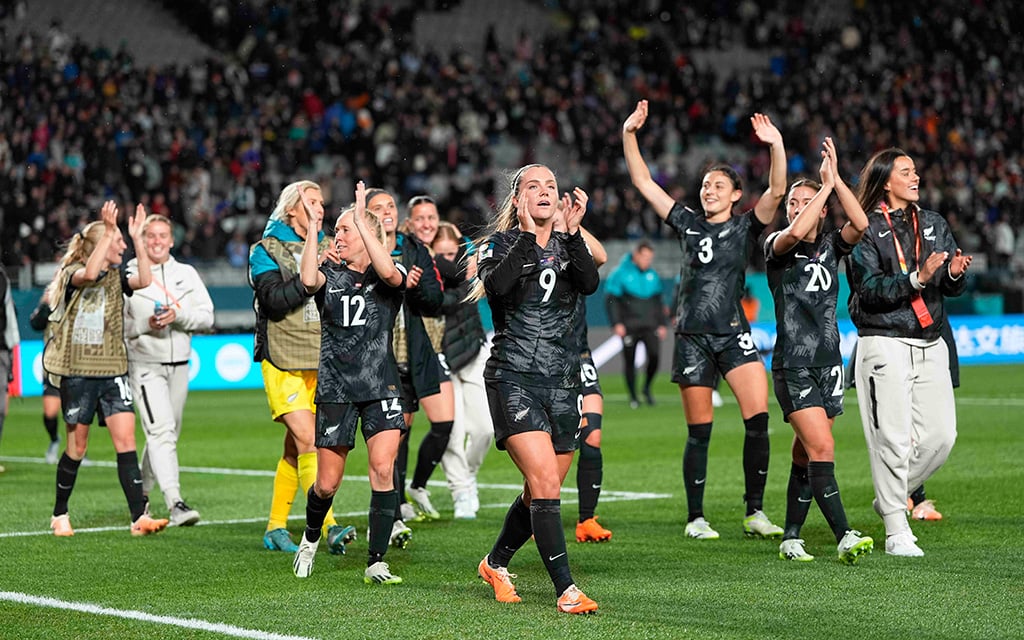
For many years, media coverage of female athletes was limited. That’s beginning to change, and in November, the Women’s Sports Network launched the first-ever 24-hour streaming network dedicated to women’s sports. (Photo by Phil Cole/Getty Images)
PHOENIX – Stacy Bauman grew up in the 1980s and ’90s. The only time the former sports journalist saw female athletes on television was during the Olympics. Now, Bauman manages the Women’s Intersport Network for Kansas City (WIN for KC), an organization dedicated to empowering girls and women through sports and fitness.
Times are changing and women’s sports are surging.
“Almost every Friday night, we can turn on the TV and we can watch women’s basketball,” Bauman said of the evolving landscape. “We can watch any gymnastics event. We can watch women’s soccer.”
The 2023 Women’s World Cup final earlier this month saw record numbers of television viewers watch as Spain defeated England, 1-0, capping off a tournament that drew record numbers of fans at the stadiums in Australia and New Zealand.
It’s a worldwide trend that’s also felt nationally. This year’s NCAA women’s championship became the most-watched women’s college basketball game in television history, with 9.9 million viewers. Two weeks later, the NCAA women’s gymnastics championship brought in just over a million viewers, breaking a 16-year viewership record for the sport.
With so much to watch and even more female athletes to follow, a new network emerged less than a year ago to cover it all. In November 2022, the Women’s Sports Network (WSN) launched as the first-ever 24-hour streaming network dedicated to women’s sports. Partnering with 12 professional women’s sports leagues, including the WNBA and the LPGA, the network broadcasts games and produces original programming, including a daily studio show called “Game On.”
“It’s amazing. It’s needed,” said Keyser Santana, who participates in a recreational sports league in Phoenix called OutLoud Sports. “It’s about damn time.”
Many broadcast attempts devoted to women’s sports have failed. However, due to societal changes, an increase in the popularity of women’s sports and advancements in technology, industry leaders agree the time is right for the Women’s Sports Network.
Bauman’s childhood followed the birth of Title IX in 1972. The landmark legislation prohibits sex-based discrimination in any school or any other education program that receives federal funding. Fifty years later, it has significantly helped increase gender equality in sports and grow women’s sports.
The legacy of Title IX can be seen through the work of Carol Stiff. A former college basketball and field hockey player and coach, Stiff joined ESPN in 1990 and pioneered bringing women’s college basketball and the WNBA to the network. She retired as ESPN’s vice president of Women’s Sports Programming in 2021 and now chairs the Women’s Sports Network advisory board.
In 1995, Stiff reached out to Pat Summitt and Geno Auriemma, the women’s basketball coaches at the University of Tennessee and University of Connecticut, to organize a non-conference game between the ranked teams to be nationally televised on the Martin Luther King Jr. holiday.
“I said to the women’s side of the ledger, you’ve got to play out of conference,” Stiff said. “Because on a Sunday afternoon, you’re up against the NFL and it’s not working. Playing Sunday up against the NBA isn’t working. We are not being seen. So if you guys could step away from your conference, and play in these better windows, I think it will grab the eye of the fan.”
The Huskies defeated the Vols in a ground-breaking matchup that helped catapult women’s basketball to national prominence.
The following year, Stiff was instrumental in showcasing the USA Basketball Women’s National Team games on ESPN. The team went on to win gold at the 1996 Olympics in Atlanta, a success that gave birth to the WNBA that same year. A short time later, Stiff asked to have WNBA games shown on ESPN and its parent subsidiary, ABC.
“We put four WNBA games on ABC,” Stiff said. “Now fast-forward to where we are today with all the ABC windows. That’s because I raised my hand in a room.”
Heading into its 27th season, the WNBA announced 25 games will be nationally broadcast during the regular season across ABC, ESPN and ESPN2. And for the first time, the WNBA All-Star Game aired in primetime on ABC.

A recent study conducted by The National Research Group and Ampere Analysis discovered that three out of 10 U.S. sports fans said they are watching more women’s sports now compared to five years ago. (File photo by James Franks/Cronkite News)
Viewership growth
More games mean more viewers. Research has shown that more people are watching women’s sports than ever before.
A recent study conducted by The National Research Group (NRG) and Ampere Analysis discovered that three out of 10 U.S. sports fans said they are watching more women’s sports now compared to five years ago, and nearly 40% of Gen Z sports fans are consuming more women’s sports.
Mary Moczula, the global marketing and communications director for NRG, and her colleague Jay Kaufman, head of sports for NRG, are among the group of authors of a study called Leveling the Playing Field: The Future of Women’s Sports.
Their research found that the biggest reason people are watching more women’s sports is that more women’s competitions are broadcast, which is noteworthy given U.S. media companies spend 0.2% of their broadcast rights budgets on women’s sports.
According to Samba TV, an audience analytics company, the WNBA, National Women’s Soccer League (NWSL) and the women’s NCAA basketball tournament all saw leaps in viewership in 2022, significantly outpacing the year-over-year growth of their male counterparts.
Even more compelling research has come out of Sports Innovation Lab, a technology-powered market research firm co-founded and headed by Angela Ruggerio, a four-time Olympian and ice hockey gold medalist. In 2022, it published the largest observational study ever conducted on the spending habits of fans of women’s sports called The Growth of the Women’s Sports Community Report.
Per the report, fans of women’s sports, or “FoWS,” tend to tune in and support as a community and that community is steadily growing while the general sports fan community is gradually decreasing.
The report also explored what distinguishes fans of women’s sports from general sports fans.
“FoWS are action-oriented with their values and have rallied for causes beyond equal pay, equity of participation, and other critical gender issues,” the report stated. “Messages anchored in social justice, sustainability and human rights resonate and drive interest in athlete stories that keep fans engaged before, during and after the season ends.”
Altogether, Sports Innovation Lab’s findings contend the community’s strong acquisition and retention of fans make investing in women’s sports “a smart bet.”
Christine Brennan has broken through many gender barriers in sports journalism throughout her 40-year career. The award-winning national sports columnist for USA Today said the market for women’s sports had always been there. It’s the attitudes that are now progressing.
“Frankly, it was just blatant misogyny and sexism that has been the hallmark of decision-making at most networks and in most broadcast meetings for generations,” Brennan said. “Things are changing dramatically and the power brokers are realizing it.”
Brennan compared the history of televising and marketing women’s sports to a race. While men’s sports have had a decades-long head start, women’s sports are just getting out of the blocks with a tremendous amount of growth potential.
The NCAA men’s Final Four began in 1939, but the first women’s Final Four didn’t come along until 1981, for instance. There’s a 50-year gap between the founding of the NBA in 1946 and the WNBA in 1996. And while the men’s FIFA World Cup debuted in 1930, it took 60 years before the first women’s cup was held in 1991.
“If you’re investing, why aren’t you investing in women’s sports?” Brennan said. “Why aren’t you investing in women’s sports networks? Because it’s such an untapped market.”
Moczula said that based on the research her team has done, it’s a market that can be built into something profitable.
“This is not a charity case. This is a real business opportunity,” Moczula said.
The arrival of the Women’s Sports Network
It’s an opportunity Stuart McLean, the CEO of FAST Studios, jumped on. Stiff said after McLean read the Sports Innovation Lab’s report, he was inspired to create the Women’s Sports Network.
FAST Studios operates an array of “FAST channels,” which stands for “free, ad-supported television.”
“FAST is a live, linear and growing area of the streaming universe that has emerged as a complement to on-demand offerings,” Dade Hayes of Deadline wrote.
As Stiff said, “All those channels that are available for cord-cutters are available now for free.”
As a FAST channel, WSN is accessible on several streaming services including Amazon, FreeVee, Roku and TubiTV.
“Fubo is proud to be one of the first streaming platforms to bring Women’s Sports Network to consumers,” Jennifer Press, communications head for FuboTV, said in an emailed statement. “WSN’s programming is a perfect fit for Fubo, which delivers over 55,000 live sporting events each year to our U.S. consumers alongside leading entertainment and news content.”
Stiff said no formal viewership ratings information is available yet as WSN is not rated on Nielsen, but the network is in 85% of all U.S. homes through free streaming channels.
WSN is touted as a storytelling-focused, digital platform. In addition to the flagship show, “Game On,” the network is partnering with champion athletes for its “The World According To” series – the first of which is hosted by world champion surfer Sage Erickson. WSN also produces documentaries and provides digital content across social media.
“I look at the network right now as the surround sound of what ESPN and all these major networks have the [broadcast] rights to,” Stiff said. “And there’s no problem with us saying, ‘Hey, we just did this pregame for the New York Liberty, now go over to ESPN and watch the game.’ We have no problem cross-promoting because a rising tide lifts all boats.”
Along with the WNBA and LPGA, the network also has partnerships with Athletes Unlimited, Premier Hockey Federation, Street League Skateboarding, U.S. Ski & Snowboard, Women’s Football Alliance and World Surf League.
McClean has surrounded himself with an impressive team of advisors. In addition to Stiff, WSN’s advisory board includes Ruggiero, 11-time Olympic medalist Allyson Felix, ESPN WNBA analyst LaChina Robinson, Kathleen Francis, national board chair of Women in Sports and Events (WISE), Sophie Goldschmidt, CEO of U.S. Ski & Snowboard, and Julie Uhrman, founder and president of Angel City Football Club.

(Graphic by Peyton Gallaher/Cronkite News)
Others have tried and failed
Women’s sports were on the rise in the 1990s. The U.S. Women’s soccer team won the World Cup in 1991 and again in 1999, the latter setting the record as the most-watched soccer game in U.S. history. In 1996, the U.S. women’s gymnastics team won gold at the Summer Olympics and the women’s hockey team took home gold at the 1998 Winter Olympics.
In addition to ESPN and the “Big Three” networks (ABC, CBS and NBC), others took on women’s sports but their efforts were short-lived.
Lifetime, a basic cable channel that bills itself as “television for women,” began airing a share of WNBA games in 1997, as well as other professional women’s sports.
“We are letting women know that there is professional women’s sports on TV,” Doug McCormick, then head of Lifetime, told The Washington Post that year.
But three years later, Lifetime, a product of Hearst/ABC-Viacom Entertainment Services, restructured its deal with the WNBA, shifting its game coverage to ESPN2 to focus on “story-oriented sports programming.”
In 2000, Lifetime discontinued coverage of several other women’s games and tournaments, including a women’s college basketball tournament and an LPGA Tour event. Also in 2000, the Oxygen Channel surfaced as a new cable channel geared toward women viewers. The Sports Business Journal heralded it as a “leader in women’s sports coverage.”
Oxygen started airing WNBA games in 2002. Two years later, the network decided not to renew its agreement with the league. NBCUniversal acquired the network in 2005.
“Oxygen struggled early to survive as it searched for a signature style of programming,” Derek Baine, a media analyst for SNL Kagan told The New York Times in 2007. “They burned through $300 million in financing in the first five years and only started to break even in 2005.”
Efforts were also made across the border in Canada. In 2001, the Women’s Television Sports Network (WTSN) launched as the world’s first 24-hour television network exclusively dedicated to broadcasting women’s sports. The venture was brief as well, shut down by its parent company CTV Speciality Television in 2003.
WTSN’s business plan projected 714,000 subscribers in its first year of operation. But in 2003, only 438,000 had signed up, according to William Houston of The Globe and Mail.
“Its audiences ranked lowest among the sports diginets and so did its advertising,” Houston wrote.
Sports networks have proven to be hard to sustain regardless of their gender focus. In 2014, Sinclair Broadcast Group launched the American Sports Network (ASN) as an outlet broadcasting both men’s and women’s collegiate sports.
Along with securing broadcast rights with several college athletic conferences, the network also had agreements with Minor League Baseball, Major League Soccer and the International Motor Sports Association.
After three years, ASN was closed and its broadcast rights were folded into Sinclair’s newest outlet, Stadium.
“It’s a sudden end for a network that in theory should have worked, but the execution and production didn’t quite catch on,” Ken Fang wrote for Awful Announcing in 2017.
Kathy Kudravi, executive director of campus communications and publications at the University of Arizona Health Science and an award-winning sports journalist, was the editorial lead for ASN’s digital platforms and created the network’s weekly digital magazine-style show.
Kudravi said American Sports Network’s time was brief, in part, because it didn’t have a shared vision of amplifying storytelling within the live-game broadcasts.
“We’d be like, ‘Well, we’ve got this great story that we did, you can use it out here (during the game broadcast),’” Kudravi said. “Because some of the outside crews we hired were not employees, they were just like, ‘Yea, we’re just here to put the game up.’”
Kudravi also said obtaining broadcast rights was a struggle because ESPN would “lock up most of the sports” with their deals with the NCAA and individual athletic conferences.
Lydia Craver is a sports media veteran with more than 20 years of leadership experience, including nearly 15 as an editor with ESPN. Now a sports editor for the Charlotte Observer, Craver said funding, or lack thereof, will make or break a network’s goals.
“Use ESPN as an example,” Craver said. “They launched the Longhorn Network. They launched the SEC Network and the ACC Network. There’s a tremendous amount of advertising and a parent company of Disney behind that. So when you have that kind of backing, you can push something forward a lot easier.”
Stiff agreed that securing advertising dollars was a crucial piece of the puzzle during her time at ESPN.
“That’s the great trifecta,” Stiff said. “You have the league, you have the media outlet, and now you have sales. Sales were what was missing.”
Keys to success
Industry experts shared their advice for WSN to succeed long-term. A common theme was to focus on storytelling.
“Tell me something beyond somebody being good,” Kudravi said. “Storytelling underlines everything we do. There has to be an underlying story idea that tells you why you should care. And for the network, that’s a way to stand out.”
Moczula noted the mega-hit Netflix docuseries “Cheer” as an example of how deep dives on particular sports could strike gold. When the series’ second season was released in 2022, it became the No. 1 show on Netflix within hours, according to PureWow. Most importantly, it drew viewers to the sport of cheerleading.
“There’s that opportunity to build the narratives before the game comes on,” Moczula added. “And building up those young, up-and-coming stars and their stories from the beginning, so that you can grow up with that athlete and get just as invested as you did with the LeBrons and Kevin Durants of the world.”
Bauman said young girls seeing stories centered on female athletes can have a lasting impact.
“It’s just immeasurable what it could do to change a girl’s life if she reads or sees a very crucial interview and is moved by it and motivated by it,” Bauman said. “You just never know. And that’s why I love sports journalism. You never know what impact your words, your story, and your products, can have on someone else.”
Having the right people tell those stories is equally important.
“I would find some personalities, like a core personality group that you want to utilize as sort of the face of what you’re doing,” Kudravi said. “Having somebody that people can connect to.”
To that end, “Game On” is hosted by former Harlem Globetrotter and social influencer Crissa Jackson, sports reporter Taylor Felix, sports influencer and former college basketball player Jenna Bandy and sports reporter and producer Jess Lucero. The show also includes a “fourth chair,” where athletes and women’s sports influencers are interviewed.
Industry leaders stressed the importance of taking an innovative approach to marketing, advertising and sponsorship deals.
“You can make the mistake of only marketing to women when it should be marketed to sports fans,” said Janae Adams, who represents media talent for CSE Talent Agency. “I would hope this network doesn’t only create a space for female viewers because men watch women’s sports as well.”
Kaufman, who oversaw strategy for the NBA for 22 years prior to joining NRG, said it’s beneficial to identify partnerships that encourage fans to get invested in the athletes, teams and storyline.
“There’s creative ways to do that that’s not necessarily massive amounts of money changing hands, but ways to use content and access to generate interest,” Kaufman said.
Few people interviewed had heard about WSN. However, the network’s social presence has grown, from 6,600 followers on Instagram in late February to over 9,400 followers in late April. Stiff said the marketing plan for WSN is still in its early stages, but the network recently announced its first major partnership deal with Michelob ULTRA.
Veterans in the field were honest about the hurdles WSN would encounter as a streaming network, but all agreed the potential is boundless.
“At the end of the day, there’s an X number of people who are on these platforms,” said Ruth Feldblum, director of WIN for KC. “And they’re getting pulled into all these different directions. We’re all so distracted. I feel like that’s probably one of the biggest challenges is just you’re in competition with so much other content.”
Demetri Ravanos, content director for Barrett Sports Media, said streaming content requires an invested interest from the consumer.
“You are automatically talking to a smaller audience than something on television where you can just stumble upon stuff,” Ravanos said. “I think anybody that talks to a very niche audience would be well served to consider farming out some content.”
Ravanos recommended the network share its content with larger platforms like Netflix for greater reach.
“I think that it would be a shame to put that on their own emerging platform because it would limit the impact that they are trying to have and it could have a huge impact,” Ravanos said.
However, Kaufman said there are opportunities from a streaming perspective that don’t exist on traditional television by using creative camera angles, commentary, stats, packages and graphics.
“If you can take advantage of those you can create a unique fan experience,” Kaufman said.
Streaming is the future, Kraver said. “If you’re looking for younger demographics, that’s where it is.”
And it’s a future that should bode well for WSN. According to The Fan Project Report, fans of women’s sports are “some of the most technologically savvy consumers in sports. They’ve been on digital platforms more frequently and for a longer period of time than other communities of sports fans.”
Kudravi, who knows the ups and downs of starting a new network all too well, said her biggest piece of advice is for the network to discover its identity.
“I wish them luck,” Kudravi said. “I hope that they’re able to survive and find that audience and grow. You can’t compare yourself to ESPN or CBS. You’ve got to be you.”
For Bauman, WSN provides an opportunity for her 9-year-old daughter to experience what was once just a dream 40 years ago.
“I can show her these are other women in sports,” she said. “These are people who can be your role models. These are things that we can talk about because we see them now. It opens up a whole new world for a whole new generation of girls.”

